cemagraphics/iStock via Getty Images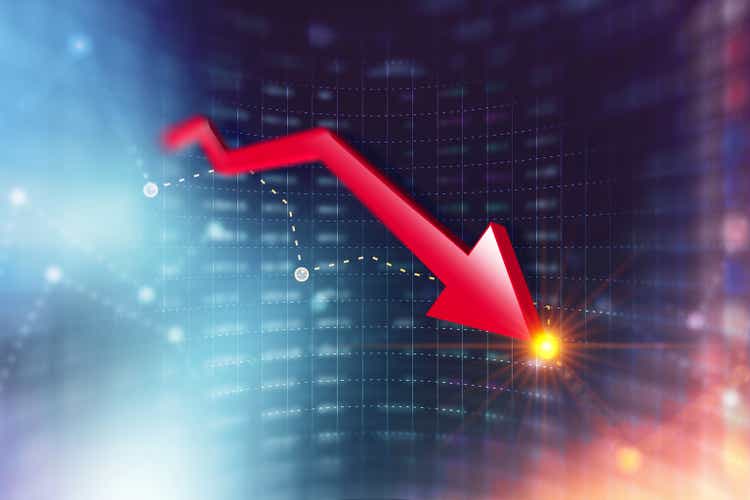
On Feb 2023 dYdX will unlock a massive amount of dYdX (DYDX-USD) tokens for investors and employees, which makes dYdX token a hard pass, a sell, or even maybe a short candidate in our book. The supply will double very soon, on February 2nd. Then by next year it will 5X which will dilute the value of each token even more.
We can’t fully recommend shorting this token because we don’t know with certainty what the investors and employees will do with their liquid tokens. But, we will explore the possibilities and probabilities in this article and let our readers make up their minds on that possible path. Our base case is a game theory optimal decision by the collective group of investors to sell ~50% of their total token interest and keep the rest for 10 + years.
dYdX has some of the worst tokenomics in the whole of crypto. In our six years of crypto, we have witnessed many projects implode due to bad tokenomics all the while being decent projects to say the least. On many occasions we have used these events to make a profit. dYdX has the second largest inflation in all of crypto and, us being economists, just can’t fight the obvious supply and demand imbalance and likely price destruction via dilution or sell pressure that is about to occur.
What is dYdX?
dYdX is a decentralized exchange, also referred to as a “dex,” that offers perpetual futures contracts on its semi-decentralized exchange, which are comparable to other centralized exchanges such as Binance, or the previous FTX exchange (R.I.P). Using dYdX, traders can short-sell tokens, increase exposure by longing with leverage, or earn interest/rewards on deposited tokens. The long term objective of the protocol is to create a fully decentralized derivatives exchange where no one person or entity, not even the development team, can have control over the protocol’s core functions.
The exchange is named after the differential equation for derivatives notation in calculus “dY/dX” also known as Leibniz’s notation. The exchange was founded in 2017 and went live in 2019. dYdX token’s initial coin offering (ICO) was on September 9th 2021.
dYdX was minted as an ERC-20 token on the Ethereum blockchain along with the initial dYdX protocol running on Ethereum. Now, dYdX protocol is operated on the Layer-2 (L2) StarkEx network which has lower fees and faster transactions for users, relative to L1 Ethereum while still benefiting from Ethereum’s security as all other ETH L2 chains do. But, recently dYdX announced intentions to build “dYdX V4 as a standalone blockchain based on the Cosmos SDK and Tendermint Proof-of-stake consensus protocol.”
- Side note: dYdX platform users might be eligible for StarkEx token airdrop if there ever becomes one, as it is a major project without a token and dYdX is the biggest platform to use StarkEx technology. But, I digress, away from air-drop hacking my fellow crypto degens.
dYdX token utility and the lack thereof
The token dYdX has two uses as of now. First, it is a governance token which gives the holder the right to participate in the governance of the protocol and the future changes and budget allocations. Second use for the token is discount utility. Token holders get discounts on trading and can also stake their tokens to earn interest. Tokens which have some sort of utility, can be classified as utility tokens and have a better chance of passing the “The Howey Test” and not being classified as securities.
dydx.exchange/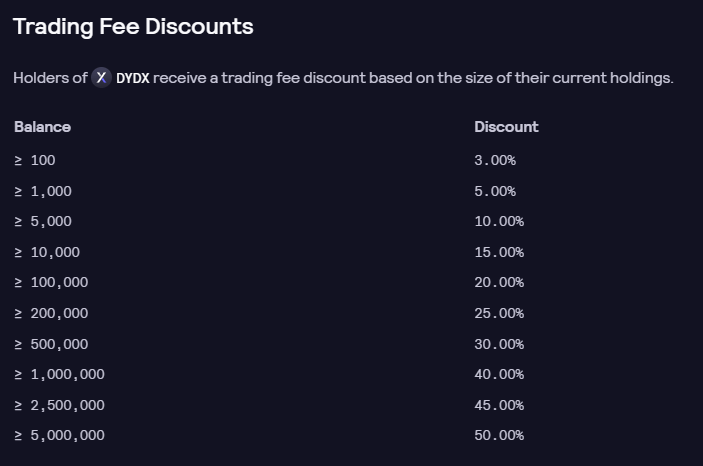
Popular misconception is that the dYdX token holders are entitled to profit sharing from the platform fees similar to a shareholder in a traditional exchange. As of now, that is not the case, nor are there any plans to make it so, as this would most likely make the token be then classified as a security according to the Howey Test, and entangle the exchange which is domiciled in San Francisco, California, in a slew of legal issues at least in the US.
Even if the revenue was shared with the token holders the exchange is paying out more in rewards than is making in revenue. Additionally, the daily average users count is only 1,650, which doesn’t scream popular.
messari.io/report/state-of-dydx-q3-2022
Funding and Token Supply
According to CrunchBase, the total funding amount was $87M over 4 funding rounds.
crunchbase.com/organization/dydx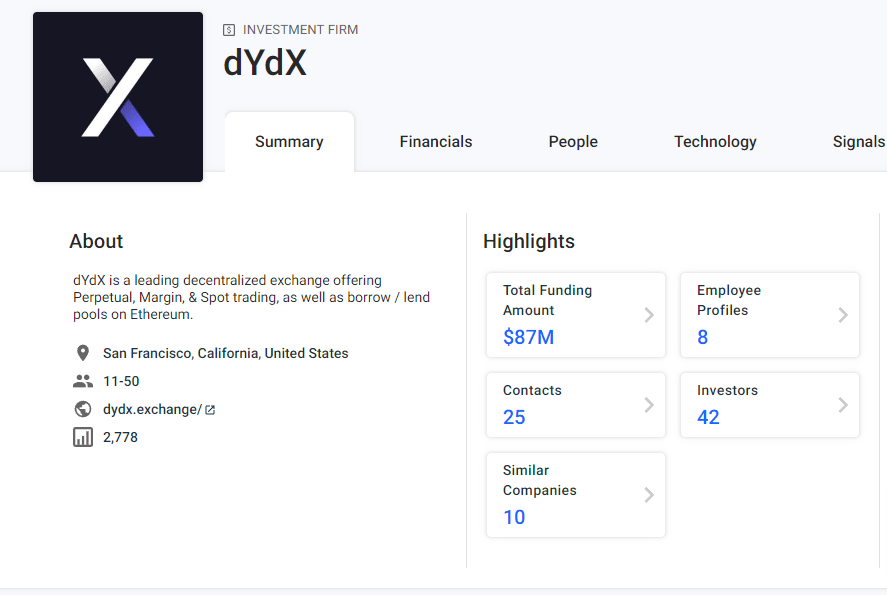
On the DefiLlama chart below, we can see the market capitalization during Series B &C funding rounds, release of the dYdX token on August 3rd 2021, as well as the trading competition. Current market capitalization sits around $200M, but we can see in the chart below it has been as high as ~$1.3B during the height of the 2021 bull market.
defillama.com/protocol/dydx?showMcapChart=true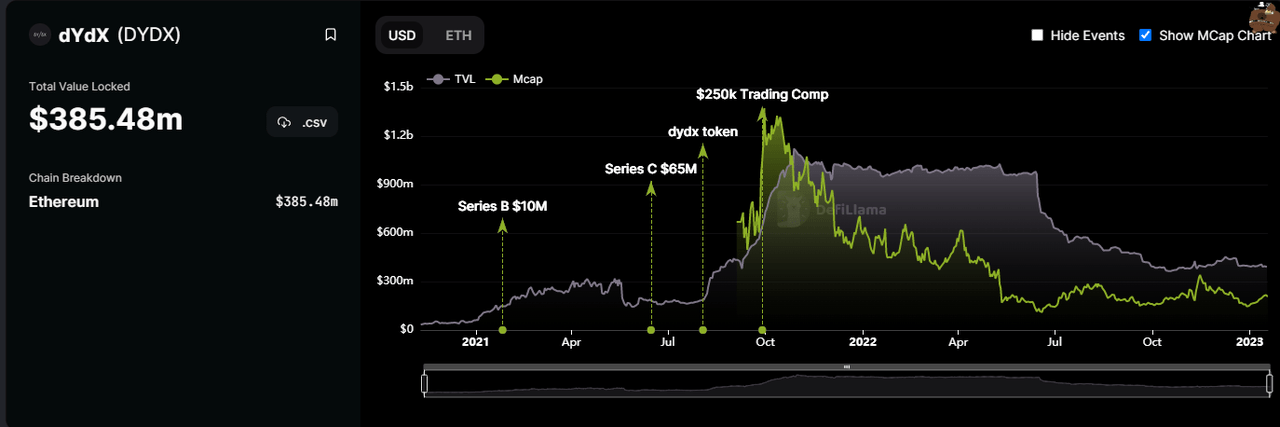
Total and circulating supply of dYdX token
dydx.community/dashboard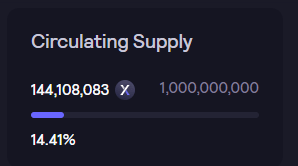
According to the dYdX website there were a total of 1 billion dYdX minted, which are to be distributed over a five year period, starting on August 3rd 2021. Current circulating supply is 144,108,083 according to the dYdX community dashboard above.
Token allocation breakdown
-
50.00% of the supply will go to the community (500,000,000 DYDX)
-
25.00% will be used as trading rewards (250,000,000 DYDX)
-
7.50% will be set aside for retroactive mining rewards (75,000,000 DYDX)
-
7.50% will be assigned for liquidity provider rewards (75,000,000 DYDX)
-
5.00% will go to a community treasury (50,000,000 DYDX)
-
2.50% will be dedicated to users staking USDC to a liquidity staking pool (25,000,000 DYDX)
-
2.50% – to users staking dYdX to a safety staking pool (25,000,000 DYDX)
-
27.73% will be set aside for investors (277,295,070 DYDX)
-
15.27% will go to founders, employees, advisors, and consultants (152,704,930 DYDX)
-
7.00% will be kept for future employees and consultants of dYdX (70,000,000 DYDX)
docs.dydx.community/dydx-governance/start-here/dydx-allocations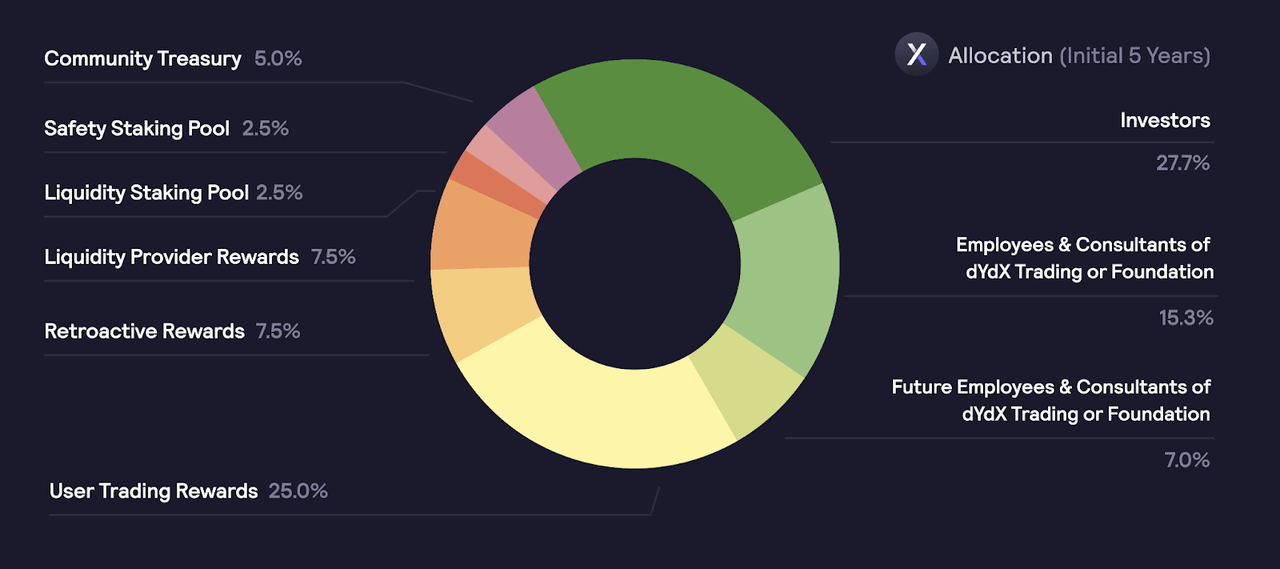
Can more dYdX tokens be minted?
Yes, five years after launch, a maximum inflation rate of 2% per year can be implemented to give the community and developers resources to continue contributing to the dYdX protocol. In 2026 dYdX community can decide via governance vote using their tokens voting power, what the maximum supply of new tokens to be minted would be, up to 2%.
docs.dydx.community/dydx-governance/start-here/dydx-allocations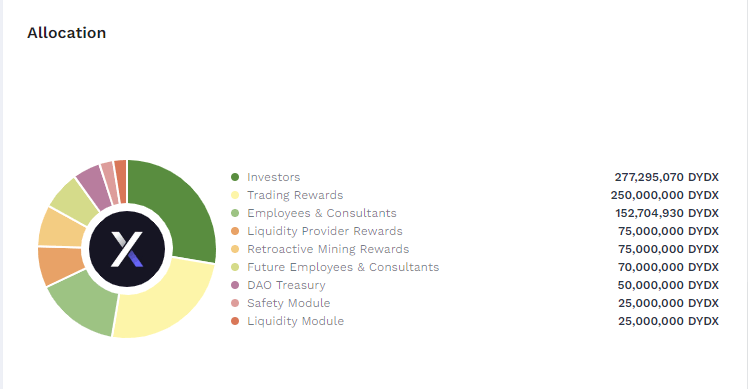
Incoming Liquid Supply Tsunami
February 02 2023, marks a massive unlock period that starts off with a bang and continues to add fuel to the fire every 30 days.
Unlock dashboard (token.unlocks.app/dydx)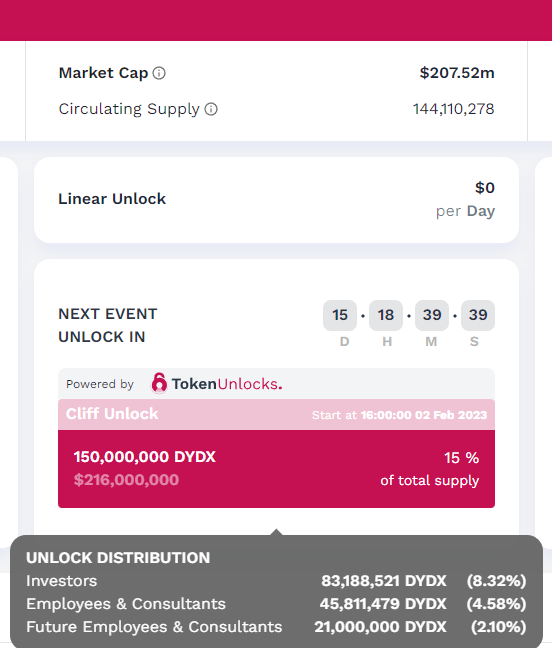
This means that on Feb 2, 2023, the supply goes from 144,110, 278 plus additional 150M to a total liquid supply of 290,000,000.
And if the current market value of $207.5M would be divided by the new diluted supply of 290M, it would imply a token price of ~ $0.70 (207.5/290), which is about 50% lower than price of $1.44 at the time of writing.
But wait – there’s more.
-
Daily trading rewards unlock every month and adds ~3.8 Million tokens of liquid supply
-
1.1 million liquidity provider rewards once a month
-
Liquidity module : 378,788 each month
-
Safety module : 378,788 each month
Monthly total: 5.6 million
And that’s not all.
The liquid supply keeps increasing by ~40M extra tokens every 30 days on top of the 5.6M monthly.
So by this time next year on Jan 16, 2024 the total liquid supply will be 711,363,637.
711,363,637 / 144,108,083 = ~5.
See chart below for the unlock cliff coming in February and the influx of tokens that follows, reaching 1 billion by 2026.
dydx Unlock schedule (token.unlocks.app/dydx)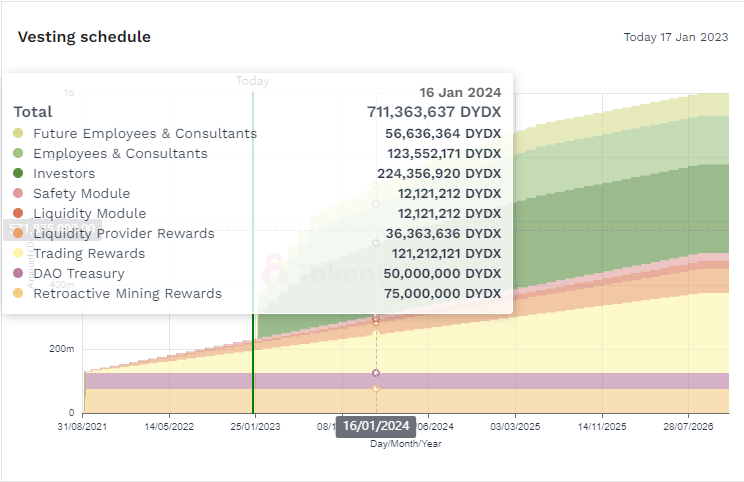
So over the next 12 months the liquid supply will be 5 X from today. Are you interested in that much dilution? Because we are not.
By this time next year the dilution adjusted token price by today’s market cap. is about $0.3 ($207M/711dYdX= $0.29 dYdX), which coincidentally is about the average cost investors paid for their tokens.
Game theory
Game theory arguments suggest that it would be in the best interest of the investors to at least recoup their initial $87 million, while they can. This would imply a sell pressure of about half the unlock amount. This action would bring the risk down to 0 while still allowing them to bet on the long term success of the project.
Rule #1 of investing is: DON’T LOSE MONEY.
We will come back to the rule#1 when we discuss dYdX’s biggest investor.
Why investors might not sell despite the incentives
Some investors won’t sell no matter what the game theoretic incentives suggest for a few reasons:
1. Reputation
Institutional reputation – is everything in the investment world, and if the VC gets a reputation as a fund that just dumps as soon as they can, they will shut themselves out of the future opportunities as they would be labeled as a bad partner. (However, this doesn’t mean they can’t sell a little bit as part of their risk management strategy.)
2. Liquidity
Investors that sell large amounts, don’t use regular exchanges like us plebs to transact. They often find a buyer and make the transaction privately off the public exchange. Public markets in crypto do not have deep liquidity that institutional investors require to transact. If they were to sell a large amount on the open market, the price would free fall. And a free fall price is not in their interest; unless, they also have a short leveraged derivative position.
3. Philosophy
Some investors have a very strict investment philosophy in early industries and companies. These investors often don’t sell for a minimum of 10 years or sometimes the hold duration is forever.
This might seem like a crazy condition to lock yourself into but, if we look at successful giant tech companies, in almost every scenario holding for 10+ years is the best and most profitable decision even if 80-90% of the portfolio companies go to zero. The few winners in the portfolio that are Google, Amazon, or Tesla pay for all the losses and still give a massive profit to those that held long term. (However, this doesn’t mean they can’t sell a little bit as part of their risk management strategy.)
Because of the reasons discussed (Reputation, Liquidity, Philosophy), we are uncertain how investors will act during the unlock, but we suspect that some will take the opportunity to cash out and color up. Cash out their dYdX tokens at a profit of 100-500% and buy currently depressed blue chip coins like ETH and BTC or even Coinbase shares (COIN) in the case of Brian Armstrong the CEO of Coinbase, a noteworthy investor in dYdX.
Long term we still project a likely game theoretic outcome since the unlock will continue for the rest of 2023 and on. The risk/reward only gets worse for current holders and those that get the unlock in early February as the supply tends towards 1 billion tokens and quintuples in the next 12 months alone, to over 700M.
Our call is to sell dYdX tokens and not look back. At least until you can get in at the VC price of $0.3 per token.
Why some investors should sell
With their $87M investment the VC investors secured 27.73% of the total supply, a whopping 277,295,070 dYdX tokens.
With some high level differential multivariate calculus below, we can see that their per token average price comes out to ~ $0.31/dYdX.
Complex math >> $87,000,000 / 277,295,070 dYdX = ~ $0.31/dYdX
Most of the investors listed have a personal or firm philosophy on taking profit. Most of them subscribe to a long term investment philosophy as tech investors should. In order to adhere to rule #1 of investing and to play with house money, so to speak, the investors will need to sell at least $87M in value to recoup their initial investment. dYdX has a who’s who of a crypto investors list. Most notably Andreessen Horowitz (a.k.a. A16Z), Polychain, Paradigm (the largest investor at $65M), and sadly also the now blown up hedge fund, Three Arrows Capital (a.k.a. 3AC).
dydx investors list (crunchbase.com/organization/dydx/investor_financials)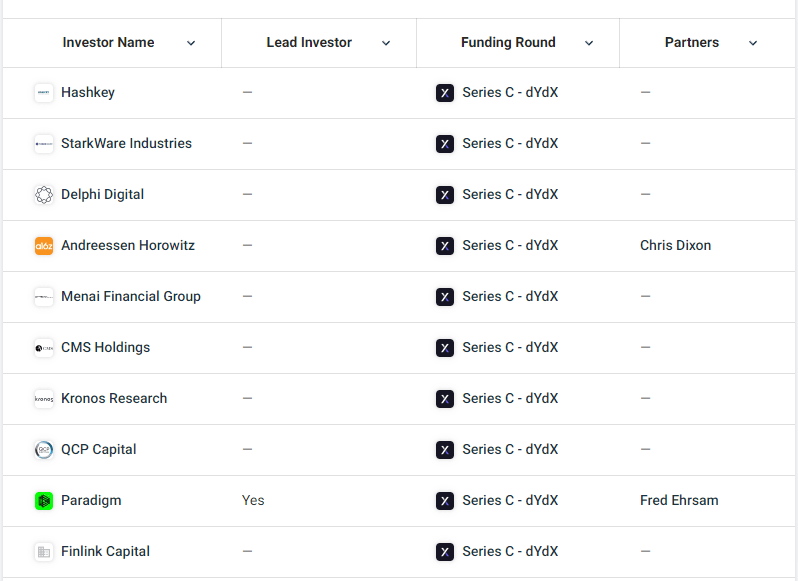
The noteworthy investors above are known for long term holding. A16Z has an insanely impressive IPO or acquisition exit list.
3AC is now bankrupt, so their dYdX assets will most likely be liquidated to pay creditors. 3AC gives us one forced selling domino in the sell pressure that may manifest once the tokens are unlocked.
4 rounds of investors (crunchbase.com/organization/dydx/investor_financials)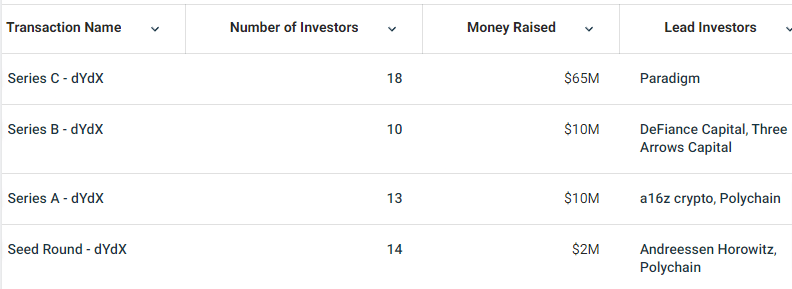
Matt Huang, a co-founder of Paradigm, said on twitter that the venture capital company wrote down its entire stake in the collapsed FTX exchange. A total of $290 million was invested by Paradigm in a collection of companies run by former FTX CEO, Sam Bankman-Fried. As the biggest investor in dYdX Paradigm might need to find some liquidity via their dYdX token unlock, in order to clean the pie off their face from the FTX debacle. Therefore, we will assign a non-zero probability that they will sell some and maybe a lot of their dYdX tokens once they unlock.
Will employees sell?
Unlike investors who may have a long term investment philosophy or reputations to maintain, the employees are not held to a similar standard. We believe it is a prudent financial decision to diversify one’s wealth from a single source. The employee’s current income/salary is dYdX dependent, their future investments should not be also dependent on dYdX. There are many risk factors in both investing in, and work for, a crypto project. It would be prudent risk mitigation to have a diversified portfolio of crypto or other assets, so we will assume that at least some employees understand the risk and are going to act rationally with the knowledge of incoming inflation to cash out some of their risk.
Final words
Will the unlocked tokens hit the open market and add sell pressure? We don’t know for sure how the employees and investors will act with their unlocked tokens, but the risk is too high to bet against human nature and game theory, so that is why we have liquidated our dYdX position in 2022 and do not plan to add any in 2023.
Fully diluted token value after the big February unlock is $0.70, which is 50% lower than today’s price, and gives us a fair margin of error even if the investors have diamond hands, that the market will reprice the token based on market capitalization dilution alone.
Some investors have gone bankrupt like 3AC and their tokens might hit the market as creditors get what they are owed; which might be one and only domino needed to kick off the run for the exit. The biggest investor has taken a huge hit lately and might be a motivated seller if the LPs start asking tough questions about their lack of due diligence with the recent FTX disaster.
We strongly believe that the risk of holding or buying dYdX tokens is too high given the dilution and lack of utility or value the token represents currently. If and when dYdX is able to share exchange profits with the token holders we will be willing to consider investing, but until that time, we do not see the value in this governance/discount token to justify the doubling of the market capitalization with abhorrent tokenomics.
Lastly, there is a large short elephant in the room. Any one of the investors or employees could open a short leveraged derivative position and dump their newly unlocked tokens on the open market to make a massive profit on their derivative position. Something like this might not fly in traditional markets, but in crypto this sort of manipulation isn’t far-fetched, nor illegal.




